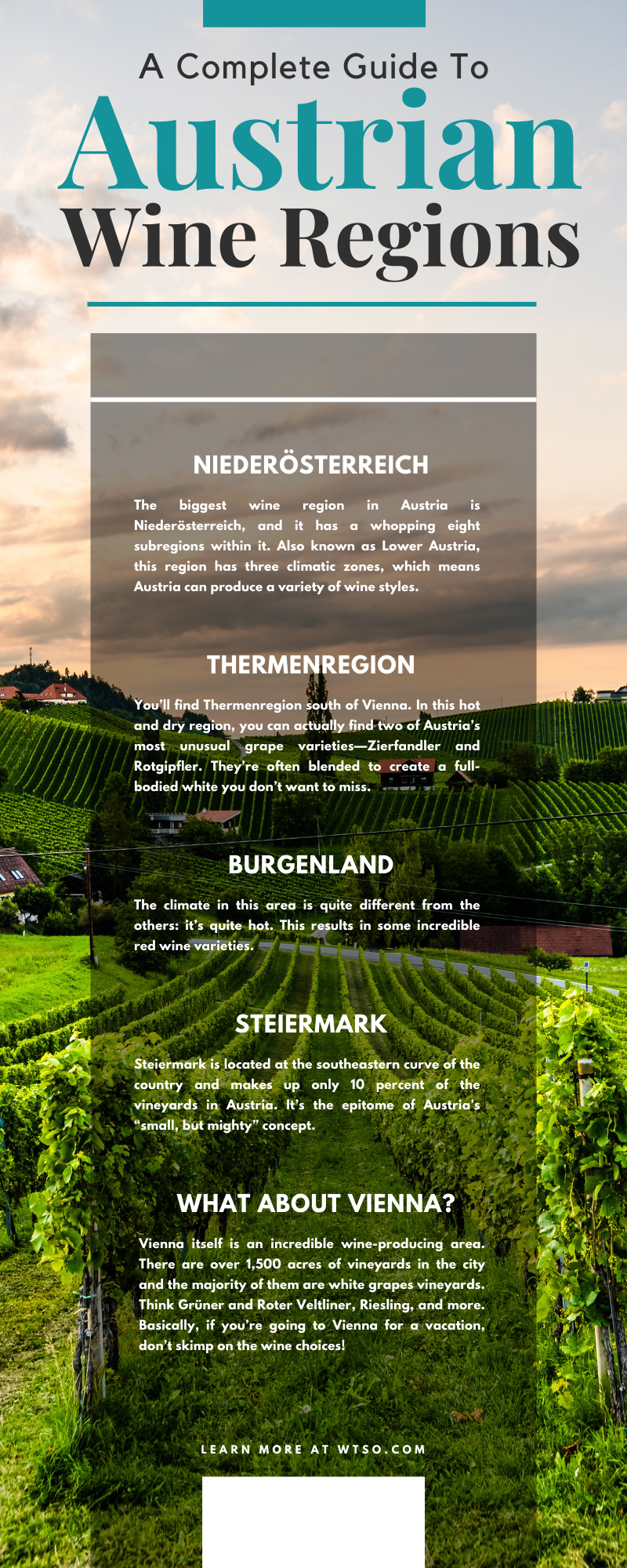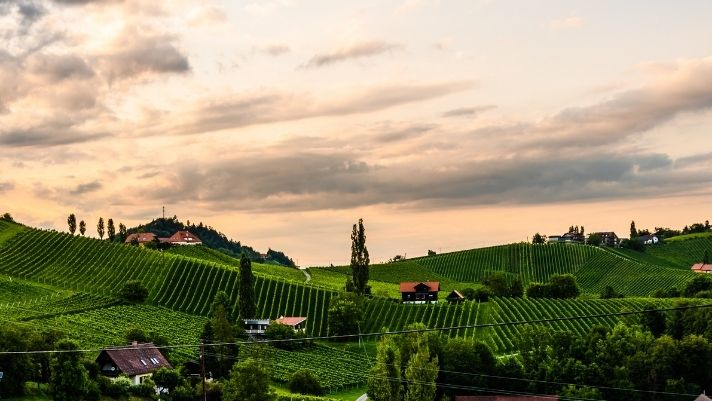As we continue through our exploration of European wine countries, we can’t forget about Germany and Italy’s neighbor, Austria. Many people don’t think of Austria when it comes to the world of wine, but in doing so, they miss out on learning some delicious history. In fact, Austrian wine has been around for quite some time; some vines go back thousands of years.
So, what does that mean for a visit to Austria’s wine country? What are their wines even like?
You wonder, we answer. Explore our complete guide to Austrian wine regions here!
Important Austria Wine Facts
Like we mentioned, the history of Austria is quite robust. Though part of you may think Austrian wine is more “New World,” since you may have just learned about its winemaking, that’s actually untrue. Grape growing in Austria began with the Celts.
Then the Cistercian monks came, hauling Burgundian varieties. Simply put, in the early centuries, Austrian wine was exploding in popularity. But then, the last century came about and it put quite the damper on Austrian winemaking. There were the World Wars, annexation, transitions in political stances. And with that came the loss of half the country’s vines. Interesting information grew from all of Austria’s hardships. Take a look:
- High Standards: Austria prides itself on quality wine. You can find well-made, artisan wines chock full of brilliant value, all for an accommodating price.
- Vineyard Size Shrinkage: Since half of its vines were lost, Austria’s vineyard area is only a bit smaller than Piemonte, Italy. But some stunning wines are within—the small country packs quite the punch.
- What About Vienna? Vienna is the only major city in the world with vineyards within city limits that make an impact on the country’s economics.
- Austrian Wine Regions: There are three main wine regions that have quite a few sub-regions within them. Learn about them below!
Niederösterreich
The biggest wine region in Austria is Niederösterreich, and it has a whopping eight subregions within it. Also known as Lower Austria, this region has three climatic zones, which means Austria can produce a variety of wine styles. Each region has some of their own specific flagship wines and styles, and those regions are: Carnuntum, Kamptal, Kremstal, Thermenregion, Traisental, Wachau, Wagram, and Weinviertel. We’ll discuss a few of the most popular ones below.
Carnuntum
Carnuntum is south of the Danube river. Although it’s one of the smallest of the Niederösterreich sub-regions, the wines here still pack a punch. The focus on wines here shifts away from whites and veers toward robust reds. Think Zweigelt, but don’t hesitate to try some smaller sinuous red options in some of the smaller vineyards.
Kamptal
One of Austria’s largest wine-producing towns is right within Kamptal. Here, you’ll find some of the most quintessential European wine views. Think storied vineyards right along the river, rolling hills in the backdrop. It’s full of gorgeous landscapes you won’t be able to tear yourself away from.
Try Out: Grüner Veltliner and their white Pinot varieties
Thermenregion
You’ll find Thermenregion south of Vienna. In this hot and dry region, you can actually find two of Austria’s most unusual grape varieties—Zierfandler and Rotgipfler. They’re often blended to create a full-bodied white you don’t want to miss.
Wachau
Wachau is a UNESCO world heritage site located in the Danube valley. The valley is full of super steep inclines, but wonderfully enough, these inclines face the south. This means you’ll get plenty of sun and quite expressive wines. The region actually has its own classification system for the ripeness of whites!
Wagram
Wagram holds Austria’s largest privately owned winery: Stift Klosterneuburg. This isn’t a region to pass by. In fact, if there’s one region to go and try a Grüner Veltliner, this may just be the place. If you sit on banks along the Danube, you’ll see lots of stunning views.
Weinviertel
The last sub-region from the Niederösterreich is the largest in the country. In fact, the region has been filling Austria’s glasses for centuries. Featuring lighter, fresher styles, this is the place that houses grapes for most Austrian sparkling wines.
Burgenland
It seems like nothing can top the Niederösterreich region, but Burgenland comes quite close, especially in the realm of red wines. The climate in this area is quite different from the others: it’s quite hot. This results in some incredible red wine varieties. There are four sub-regions: Neusiedlersee, Leithaberg, Mittelburgenland, and Eisenberg or Sueburgenland. We’ll talk about them below.
Neusiedlersee
Neusiedlersee is named after the lake to the east. It has hills, flatlands, and a great offering of grape varieties. Welschriesling and Zweigelt are the principal varieties you’ll see, but there are almost 500 wineries in the region, so you have quite a few to choose from.
Mittelburgenland
Mittelburgenland has lots of red wines. Blaufränkisch is the grape that set the tone for the area. It’s characterized by deep berry and cherry tones. Furthermore, it’s even acidic. When you drink a red wine made from such a berry, you’ll get a wine full of character. And the best part is it’s right in the middle of the beautiful countryside.
Steiermark
Steiermark is located at the southeastern curve of the country and makes up only 10 percent of the vineyards in Austria. It’s filled with rolling hills, aromatic white wines, and three beautiful subregions (Weststeiermark, Vulkanland Steiermark, Südsteiermark.) It’s the epitome of Austria’s “small, but mighty” concept. We’ll touch on the two main players below.
Vulkanland Steiermark
Volcanic soils make for some interesting wines. In this beautiful region, you’ll find Pinot Blanc, Morillon, Traminer, and so much more. And of course, there are so many divine views to take in.
Südsteiermark
If you’re looking for refreshing and fragrant whites, then Südsteiermark is a beautiful place to go. This region has extremely steep slopes, so growing grapes out there is hard work—but that the effort that goes into creating the wines only makes tasting them even more of a reward. A variety of grapes, a slew of wineries, and delicious wine—what could be better?
Try Out: Gelber Muskateller or Muscat Blanc
What About Vienna?
As we mentioned earlier, Vienna itself is an incredible wine-producing area. There are over 1,500 acres of vineyards in the city and the majority of them are white grape vineyards. Think Grüner and Roter Veltliner, Riesling, and more. Basically, if you’re going to Vienna for a vacation, don’t skimp on the wine choices!
So, there you have it—an in-depth look at a guide to Austria’s wine regions. Continue to explore wineries and styles before you visit. And of course, when you’re looking for wine to drink, you can turn to Wines ‘Til Sold Out. Once you’ve found the bottles that suit your fancy, make sure to send along some corporate wine gifts so that everyone can enjoy the beauty in wine that you do. Shop now!




